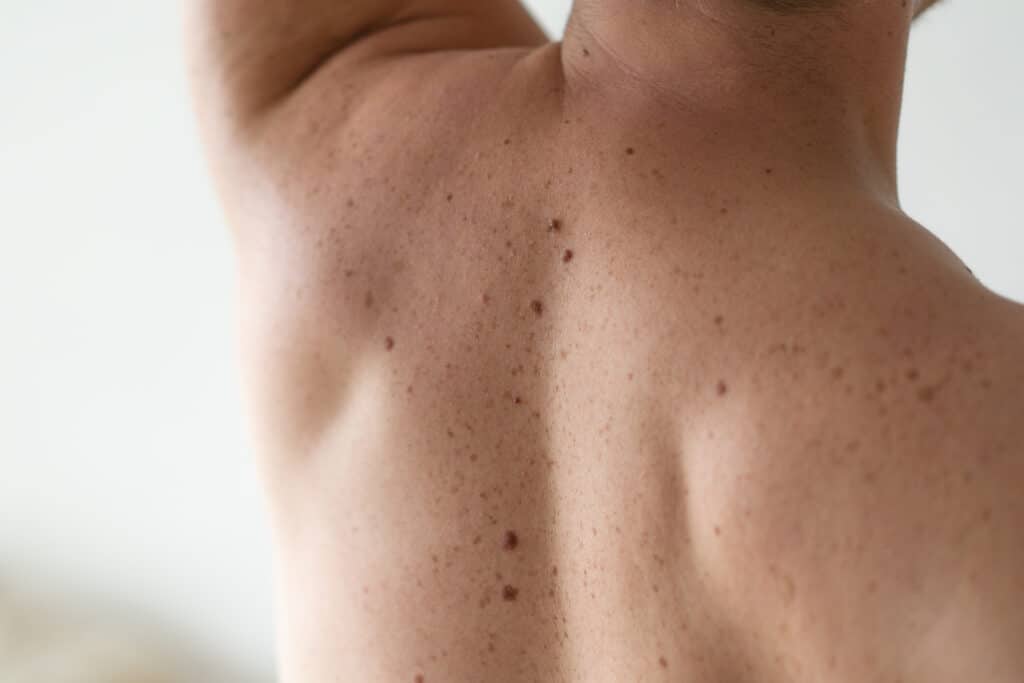As the most common type of cancer affecting Americans across the country, skin cancer can manifest in many forms. Understanding the different types of skin cancer and symptoms associated with each is a crucial part of early detection, treatment, and recovery. While yearly skin exams are important, especially for those at increased risk for developing skin cancer, regular self-exams can detect early signs of trouble.
Here’s what you need to know about the most common types of skin cancer: basal cell carcinoma, squamous cell carcinoma, malignant melanoma.
What is Basal Cell Carcinoma (BCC)?
Skin cancer affecting the basal cells, which are responsible for production of new skin cells, is called basal cell carcinoma (BCC). This most common form of skin cancer typically affects skin that receives the highest levels of sun exposure, such as the face, head, and neck. BCC is slow growing, which can make it easy to miss or dismiss. When detected early enough, basal cell carcinoma can be easily treated through topical treatments or surgery.
Basal cell carcinoma can appear as:
- A shiny, almost translucent bump on the skin
- An open sore that doesn’t heal
- A reddish, irritated patch
- A flat, white, yellow, or waxy colored raised area of skin similar to a scar
- A small, pink growth with a raised, rolled edge and crusted central indentation
- A brown or glossy black bump with a rolled border on darker skin complexions
People who have already had basal cell carcinomas are more likely to develop it again in the future, typically in the same area. Because BCC is usually caused by DNA damage due to exposure to ultraviolet radiation, recurrence can happen even after thorough removal of the affected tissue. This is because DNA damage caused by UV light changes the way basal cells function, which is undetectable until cancerous cells form.
Sun damage and exposure to UV radiation in tanning beds are the primary causes of basal cell carcinoma skin cancer, so being sun safe is vital for prevention. Avoiding sunburns and over exposure through wearing sunscreen and protective clothing can help reduce your chances of developing skin cancer.
What is Squamous Cell Carcinoma (SCC)?
The second most common form of skin cancer is squamous cell carcinoma. Similar to basal cell carcinoma, squamous cell carcinoma affects the squamous cells, which are located in the upper layer of the epidermis and assist with absorption and filtration of materials entering the body through the skin. Because these cells are so near the surface of the skin, they may also be damaged by UV rays. This sun damage can cause abnormal, accelerated cell growth, leading to SCC.
Squamous cell carcinoma is not limited to the skin. It can also occur within the body, such as in the mouth, throat, or longs. These forms of SCC are less common and can be incredibly dangerous without treatment.
For squamous cell carcinoma occurring in the skin, signs include:
- A raised growth with a central depression that may bleed, crust or scab
- A persistent, scaly patch of reddened skin with irregular borders
- An open sore that bleeds or crusts but doesn’t heal
- A new, wart-like growth that crusts and/or bleeds
- A hard, raised lesion or patch of flaky, scaly skin on darker complexions
Other than affecting different cell types, SCC differs from BCC because it grows and spreads rapidly. Squamous cell carcinoma bumps can double in size quickly, which may help with detection efforts. If you notice any rapidly growing skin growths, it is important to get it checked immediately by a skin cancer specialist.
What is Malignant Melanoma?
Though less common than the previous carcinomas, malignant melanoma is more dangerous because it may spread rapidly to other organs. Malignant melanoma is also typically triggered by sun and UV damage, causing melanocyte cells (responsible for producing melanin and giving skin its color) to grow uncontrollably.
While most people understand that melanin is a natural sun protector, it’s often vastly misunderstood. To begin, melanin actually comes in two forms: eumelanin (a dark brown or black pigment) and pheomelanin (a red-yellow pigment). Those with fairer skin tones typically have more pheomelanin while darker skin has more eumelanin. It is eumelanin that absorbs harmful UV rays and provides some protection from sun damage, which is why people with lighter skin tone are more susceptible to sunburns and cancer-causing sun damage.
That doesn’t mean people with dark complexions are immune or automatically safe from the risk of skin cancer. In fact, skin cancer has a higher mortality rate among people with dark complexions because of misconceptions about melanin’s natural sun protection. It is important to be safe in the sun no matter your skin tone because sun damage can happen to anyone.
For malignant melanoma, early detection is key to survivability. Unfortunately this can be difficult because of the various ways melanoma can manifest. Melanomas fall into four main categories:
Superficial spreading melanoma, the most common form which may begin as a new lesion or affect existing moles. It typically appears on the torso, lower back, or legs and can look like a flat or slightly raised area of asymmetrical discoloration. These patches can be tan, brown, black, red, blue, or white, but may also appear as a similar tone to the rest of your skin.
Lentigo maligna, which commonly affects older adults. It usually manifests in the sun-damaged skin of the face and head, arms, or upper torso. Lentigo maligna looks similar to superficial spreading melanoma but usually has a bluish-black appearance. It may also have coloration similar to the normal skin tone. Once lentigo maligna begins to spread beyond the original sight or becomes more invasive, it is called lentigo maligna melanoma.
Acral lentiginous melanoma, the most common form of melanoma found in African-Americans and other people of color. This form of melanoma may be harder to detect because it appears in atypical areas like the palms, soles of the feet, or under the nails. Usually acral lentiginous melanoma is a dark brown or black streak or uneven patch.
Nodular melanoma, the most aggressive form of melanoma, accounts for 10 to 15 percent of all cases. This form of melanoma occurs in deeper layers of the skin and grows rapidly, causing a blue-black, pinkish, or red bump on the surface. Because it forms lower in the epidermis and dermis, nodular melanoma is typically invasive at the time of detection, which contributes to its danger. Nodular melanoma is typically treated through surgical removal of the cancer and/or various cancer therapies, depending on the stage, location, and size.
Expert Skin Cancer Treatment in Los Angeles
A leading Beverly Hills and Los Angeles area dermatologist, Dr. Brian P. Mekelburg, MD, FAAD has over 30 years of skin cancer treatment experience. His extensive knowledge and expertly trained eye allows Dr. Mekelburg to identify and diagnose skin cancer even in the earliest stages. His commitment to compassionate, effective care means you can rest assured you are in good hands.
If you suspect you or someone you love may have skin cancer, don’t hesitate to schedule an appointment with Dr. Mekelburg today.



